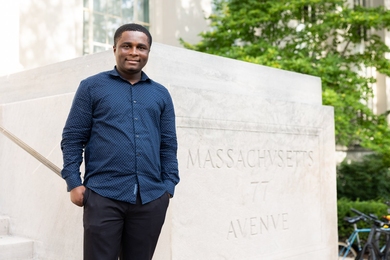Not so long ago, we in Massachusetts were the center of the computer industry. MIT and its Lincoln Laboratory spawned the minicomputer. The Digital Equipment Corporation was the quintessence of technological entrepreneurship. Companies and jobs grew around Route 128, and the Massachusetts Miracle occurred.
And then...we largely missed the fundamental transformation brought about by the "silicon revolution" of the microprocessor. The Massachusetts computer industry struggled, sputtered, and spiraled downward while Silicon Valley was born and the industry, jobs, and hot economy moved to California.
Today, in 2003, we have the greatest assemblage of hospitals, academic health centers, biomedical research institutions, and university science and engineering departments in the world. There are over 275 biotechnology firms in the Commonwealth -- around 60 in Cambridge alone. The major pharmaceutical companies have scrambled to establish a research presence here.
And a new revolution is stirring. This time it is not about silicon and microprocessors; it's about life science, technology, and medicine. It is characterized by terms like systems biology, computational biology, and genomic medicine. It builds on the recently completed sequencing of the human genome, and on fields like bioinformatics, genomics, and proteomics. And beneath it all is a base of fundamental science and accelerating technological and computational capabilities for exploring ever more complex biological and chemical phenomena, and doing it faster and faster with smaller and smaller samples.
It has to do with how the chemical parts in a human cell that are produced according to our genetic instruction set are assembled, how they interact, how they change dynamically and what their three-dimensional structures are.
It has to do with how disease states come about when one or more of these parts is missing, added, or flawed, and how to determine what interventions will prevent, inhibit, or cure these diseases.
It has to do with moving much of medical practice and discovery away from its long path of sophisticated, factor-by-factor trial and error toward a true scientific base. And it has to do with earlier and more accurate diagnosis, and with more narrowly targeted, tailored, and focused treatment.
Every person in this room should care about this revolution that is stirring.
You should care about it because we are learning profound things about what life is, how evolution occurs, how all living things are interrelated, and something of what makes us human.
You should care about it because it has deep significance for the health and quality of life of our children and grandchildren.
And you should care about it because jobs and the economic vitality of this region are at stake.
Our world-class universities and hospitals can and will lead this revolution. But the jobs and economy can grow in Massachusetts, or they can flow elsewhere. Those of us here today should be dedicated to the proposition that history must not repeat itself. The fruits of systems biology and genomic medicine should be harvested here. We can't miss this one, as we did the silicon revolution. This time, let's be nimble and committed to grow the jobs and economy here.
Now is the time to start.
Each sector and organization represented in this room has a role to play.
What about my own sector? What is the role of our universities? How do we intend to drive the underlying science?
Every study of what makes regions successful in science and technology based industries of which I am aware identifies among the critical elements of "best practice":
-- Strong university R&D support, and
-- An educated workforce.
Research universities address both of these elements and thus have a central, indeed essential role. And we have the strongest base of research universities on the planet.
The primary role our universities must play is very simple and clear: Hire the brightest men and women we can find and enable them to do what they believe is most important in research and education.
And what a great time this is in the world of life sciences in our universities!
Indeed, I believe that this is the most exciting era in science and academic engineering in human history.
The technological devices that enable scientific discovery are getting smaller, faster, more accurate, capable of ever higher data rates, and ever greater resolution in time, space, and chemical or physical characteristics. They are challenging and interesting to design and assemble. They are marvelous platforms for discovery and advancement by bright students.
And in turn, advances in scientific knowledge, especially in the chemical and biological sciences, are enabling research engineers to develop new sensors and other new tools. There is a symbiotic relationship between contemporary science and engineering. It is hard to define where one leaves off and the other begins. Actually, we don't even try anymore.
Other boundaries are blurring. Old distinctions between basic science and applied science are obsolete.
And all of this requires computer science and information technology at its core.
Simply put, the advancement of life science is causing important areas of biology, physical science, and information science to integrate and merge.
So an essential part of our missions as research universities should be to enable bright students and faculty to drive these scientific and technological advances -- to learn and discover.
But to do this, we must be nimble. It requires a breaking down of old organizational and disciplinary barriers. It requires a constant dialogue among basic scientists and clinicians. It requires new thinking about shared core experimental facilities. It requires mutual respect and synergy between reductionist scientists and the new systems scientists. It requires creative partnerships and mutually beneficial interactions between industry and academia. It requires new organizational structures to deal with scale, scope, and infrastructure. And it requires the greatest assets of our universities -- the continual influx of bright new students and faculty who renew us and keep us vital.
Such structures are emerging in our universities. At MIT today you will find, for example, a new Division of Biological Engineering, and a Computational and Systems Biology Initiative. These organizations enable biologists, chemists, materials scientists, chemical engineers, electrical engineers, physicists, computer scientists, mechanical engineers, and toxicologists to work together to educate students and do research. (By the way, these and other successful interdisciplinary initiatives generally have one other characteristic in common -- they are inspired and built by vision and cooperation from the grass roots up. They aren't first conceived as organization charts by administrators or bureaucrats.)
Such structures are also emerging across our universities. The excellence of America's research universities is driven in some measure by competition. We compete with each other for resources in a marketplace of ideas, talent. and facilities.
But for Massachusetts to lead and draw sustenance from the evolution and revolution in the life sciences, we also need to cooperate. It is the synergies of our world-class universities, hospitals, and research institutes that can win the competition for global leadership and create the yeast from which corporations, venture capitalists, and entrepreneurs can build a vital economy and quality of life.
And guess what -- it requires money. Lots of it. Some of that money is going to come from philanthropists, and some will come from enlightened companies who see beyond the near horizon. But the essential lifeblood will continue to be support from the federal government -- federal research funds invested in the best and brightest through a merit-based system of award.
It is the duty of those of you from government and industry to provide some of these resources. And it is your duty to promote strong research budgets in Washington and to insist that they be awarded on the basis of merit -- on the basis of intellectual excellence, vision, and competence. This is the way Massachusetts will sustain its leadership in the next generation of life science. And on the foundation of this leadership we can build a very important element of our regional future and contribute to the improvement of the human condition around the world.
There is a lot that can be said about the relationships between our universities and industry, about the essential importance of entrepreneurship, and about driving technology transfer. But today, it seemed to me extremely important to emphasize the fundamental importance of our universities, and to offer a glimpse of the emerging base of new science and ways of doing science within and among them.
* * *
To summarize, the key features of university leadership of the next generation of life science and medicine are: Bright people; nimble organizations that can integrate disciplines and restructure as required to do the science; competition and cooperation; and money to build the infrastructure and support the people.
Now to demonstrate and explain these concepts, I've rolled all of these things up in one individual. He's a bright scientist, nimble organizer, fierce competitor who builds cooperative organizations, and he loves to amass lots of money to do great science.
Eric Lander is also a humble mathematician who became a professor here at the Harvard Business School, but then decided he really wanted to be a biologist. And not just any biologist, but one who would both teach freshman biology at MIT and also establish and lead a huge Center at the Whitehead Institute that would sequence a third of the human genome, and in the process create an extraordinary and versatile intellectual community. He is also a highly successful biotechnology entrepreneur.
But most important to today's agenda, it is Eric's scientific vision and leadership that enabled MIT, Harvard University, and the Whitehead Institute to join forces to establish the new Broad Institute. We believe that the Broad Institute will be central to ensuring that Cambridge, Boston, and Massachusetts are the epicenter of the life science revolution and the next-generation biotech industry, and that it will be an important integrating node for our university and hospital communities.





